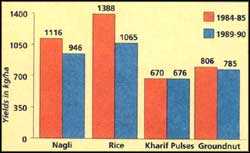Browned off
 According to David Hardiman, a historian at the School of Oriental and African Studies, London, the Bhils came to the Dangs around the 14th century, almost simultaneously with the Konkanas, who were initially subjects of the Bhils.
According to David Hardiman, a historian at the School of Oriental and African Studies, London, the Bhils came to the Dangs around the 14th century, almost simultaneously with the Konkanas, who were initially subjects of the Bhils.
The Konkanas practiced rab cultivation in the flatter regions of the valleys. Forest debris was piled on a small plot of land and burnt. Seeds of nagli (millet) or rice were sown in the ashes, which provide a good substrate for seed growth. In monsoon the area around this plot was either ploughed or hoed. Seedlings were transplanted to the prepared land, weeding carried out periodically and the crop harvested soon after the monsoons. After 2 or 3 years, the soil got exhausted and a fresh patch of land was sought.
The Bhils and the Varlis practiced kumri or dalhi cultivation, a form of shifting cultivation on land cleared in the forest. This required no ploughing. The ash from the burnt scrub was sown with nagli, which sprouted once the rains came. But the poor soil quality only gave low yields. Eacj year the site was shifted.
The 2 different methods of the Bhils and Konkanas complemented each other. Both required extensive forests and space to move about in. The villages were very small and widely scattered. According to an official writing in 1877, "The Dangs may be termed a sea of forest and trees, with small and isolated patches of cultivation scattered over it."
The British tried to persuade the Bhils to take to settled agriculture. The emphasis here was to clear the land rather than preserve the forest. Based on the 1871 Census, when the population was only 18490 people, the British had decided to allow cultivation in one-third of the total area of the district. The rest was declared as reserved forests, known as protected forests today. This ratio still prevails, but the population has gone up to 1,44,091.
This alienation from the traditional practices has led to a decline in productivity.
Related Content
- Order of the National Green Tribunal regarding depleting habitat of brown bears in Sonmarg and Baltal region of Jammu & Kashmir, 22/04/2025
- Order of the National Green Tribunal regarding protecting the habitat of Himalayan brown bear, Sonmarg, Jammu & Kashmir, 02/01/2025
- Food Safety and Standards (Food Products Standards and Food Additives) First Amendment Regulations, 2023
- Himalayan brown bear (Ursus arctos isabellinus) ecological and human-bear conflict investigation in Kashmir with special reference to bear habituation to garbage dumps in the Central Wildlife Division
- The environment and corruption: monetary vs. non-monetary incentives and the first best
- Affidavit filed by DSM Sugar Mills, Mansurpur, district Muzaffarnagar, Uttar Pradesh before the NGT, 30/11/2021
